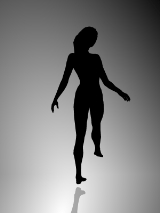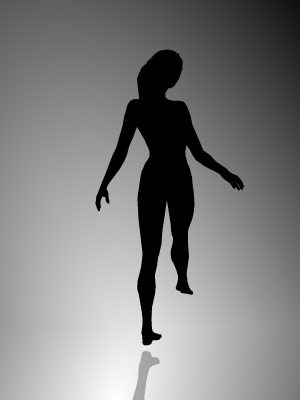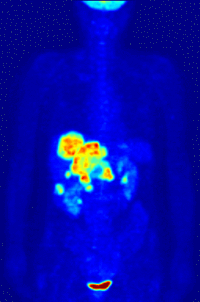
The Spinning Dancer
Encyclopedia

Multistable perception
Multistable perceptual phenomena are a form of perceptual phenomena in which there are unpredictable sequences of spontaneous subjective changes...
optical illusion
Optical illusion
An optical illusion is characterized by visually perceived images that differ from objective reality. The information gathered by the eye is processed in the brain to give a perception that does not tally with a physical measurement of the stimulus source...
resembling a pirouetting female dancer. The illusion, created by web designer Nobuyuki Kayahara, involves the apparent direction of motion of the figure. Some observers initially see the figure as spinning clockwise
Clockwise
Circular motion can occur in two possible directions. A clockwise motion is one that proceeds in the same direction as a clock's hands: from the top to the right, then down and then to the left, and back to the top...
(viewed from above) and some counterclockwise.
The illusion derives from the lack of visual cues for depth. For instance, as the dancer's arms move from viewer's left to right, it is possible to view her arms passing between her body and the viewer (that is, in the foreground of the picture, in which case she would be circling counter-clockwise on her right foot) and it is also possible to view her arms as passing behind the dancer's body (that is, in the background of the picture, in which case she is seen circling clockwise on her left foot).
When she is facing to the left or to the right, her profile is unambiguous. That is, her breasts and ponytail clearly define the direction she is facing. However, as she moves away from facing to the left (or from facing to the right), the dancer can be seen (by different viewers, not by a single individual) facing in either of two directions. At first, these two directions are fairly close to each other (both left, say, but one facing slightly forward, the other facing slightly backward) but they become further and further away from each other until we reach a position where her ponytail and breasts are in line with the viewer (so that neither her breasts nor her ponytail are seen so readily). In this position, she could either be facing away from the viewer or toward the viewer, so that the two positions two different viewers could see are 180 degrees apart. Which the viewer sees will depend on which direction of turn the viewer is visualizing.
There are other optical illusions that depend on the same or a similar kind of visual ambiguity. One example is the Necker Cube
Necker cube
The Necker Cube is an optical illusion first published as a rhomboid in 1832 by Swiss crystallographer Louis Albert Necker.-Ambiguity:The Necker Cube is an ambiguous line drawing....
.
Psychology of visual perception
The illusion has been incorrectly identified as a scientific personality testPersonality test
-Overview:There are many different types of personality tests. The most common type, the self-report inventory, involves the administration of many questions, or "items", to test-takers who respond by rating the degree to which each item reflects their behavior...
that supposedly reveals which hemisphere of the brain
Lateralization of brain function
A longitudinal fissure separates the human brain into two distinct cerebral hemispheres, connected by the corpus callosum. The sides resemble each other and each hemisphere's structure is generally mirrored by the other side. Yet despite the strong anatomical similarities, the functions of each...
is dominant in the observer. Under this unproven interpretation, it has been popularly called the Right Brain–Left Brain test, and was widely circulated on the Internet during late 2008 to early 2009. During this time it was established that the silhouette is more often seen rotating clockwise than counter-clockwise. According to an online survey of over 1600 participants, approximately two thirds of observers initially perceived the silhouette to be rotating clockwise. In addition, observers who initially perceived a clockwise rotation had more difficulty experiencing the alternative.

Bistable perception
Depending on the perception of the observer, the apparent direction of spin may change any number of times, although some observers may have difficulty perceiving a change in motion at all. One way of changing the direction perceived is to use averted vision and mentally look for an arm going behind instead of in front, then carefully move the eyes back. Some may perceive a change in direction more easily by narrowing visual focus to a specific region of the image, such as the spinning foot or the shadow below the dancer and gradually looking upwards. One can also try to tilt one's head to perceive a change in direction. Another way is to watch the base shadow foot, and perceive it as the toes always pointing away from you and it can help with direction change. You can also close your eyes and try and envision the dancer going in a direction then reopen them and the dancer should change directions. Still another way is to wait for the dancer's legs to cross in the projection and then try to perceive a change in the direction in what follows. You could also try using your peripheral vision to distract the dominant part of the brain, slowly look away from the ballerina and you may begin to see it spin in the other direction. Perhaps the easiest method is to blink rapidly (slightly varying the rate if necessary) until consecutive images are going in the 'new' direction. Then open your eyes and the new rotational direction is maintained. It is even possible to see the illusion in a way that the dancer is not spinning at all, but simply rotating back and forth 180 degrees.Slightly altered versions of the image exist in which an additional visual cue facilitates the perception of counterclockwise spin and clockwise spin. Looking at one of these can then make the original dancer image above spin in the corresponding direction.

